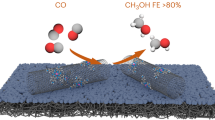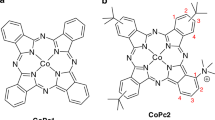Abstract
ACTIVATED carbon has been used as a catalyst in a number of methods for the preparation of cobalt-(III) complexes. It has been shown that the racemization of tris(ethylenediamine)cobalt(III) ion1 and other cobalt(III) complexes2 is accelerated in the presence of activated carbon. Since the rate of exchange in the system [Co(en)3]3+−*en in the presence of charcoal is slower than the rate of racemization of d-[Co(en)3]3+, the racemization cannot be attributed solely to a ligand exchange process3. Dwyer and Sargeson4 have observed that on boiling a solution of d-tris(ethylenediamine)cobalt(III) chloride with activated carbon for 3 min., the optical activity was lost completely and about 4 per cent of the total cobalt was reduced to Co2+. In the presence of sulphuric acid (0.1 N) and carbon, the complex was reduced to about the same extent, but the optical rotation decreased only slightly (by 6 per cent). They interpreted these results to mean that the racemization occurs through an electron exchange process involving [Co(en)3]2+. Sulphuric acid would destroy the labile cobalt(II) complex and inhibit the racemization by this mechanism.
This is a preview of subscription content, access via your institution
Access options
Subscribe to this journal
Receive 51 print issues and online access
$199.00 per year
only $3.90 per issue
Buy this article
- Purchase on Springer Link
- Instant access to full article PDF
Prices may be subject to local taxes which are calculated during checkout
Similar content being viewed by others
References
Douglas, B. E., J. Amer. Chem. Soc., 76, 1020 (1954).
Douglas, B. E., and Erdman, W. C., Abstracts of papers presented at the meeting of the American Chemical Society, Chicago, Ill., September 1958.
Popplewell, D. S., thesis, University of Sheffield, 1956, cited from Basolo, F., and Pearson, R. G., Mechanisms of Inorganic Reactions, 282 (John Wiley and Sons, Inc., New York, 1958).
Dwyer, F. P., and Sargeson, A. M., Nature, 187, 1022 (1960).
Dickens, J. E., Basolo, F., and Neuman, H. M., J. Amer. Chem. Soc., 79, 1286 (1957).
Davies, N. R., and Dwyer, F. P., Trans. Farad. Soc., 48, 244 (1952).
Author information
Authors and Affiliations
Rights and permissions
About this article
Cite this article
DOUGLAS, B., SWIFT, H. Effect of Electrolytes on the Catalytic Racemization of Tris(Ethylenediamine)-Cobalt(III) Ion. Nature 193, 1173–1174 (1962). https://doi.org/10.1038/1931173a0
Issue Date:
DOI: https://doi.org/10.1038/1931173a0
Comments
By submitting a comment you agree to abide by our Terms and Community Guidelines. If you find something abusive or that does not comply with our terms or guidelines please flag it as inappropriate.



